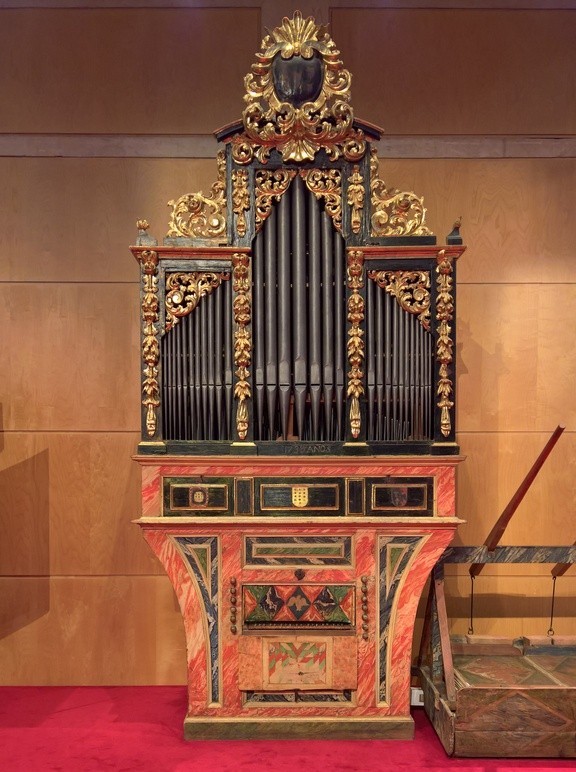Barcelona, Museu de la Música (Manuel Perez Molero Organ)
| Builder | M. P. Molero |
|---|---|
| Year | 1719 |
| Period/Style | Baroque |
| Stops | 10 |
| Keyboards | 1 |
| Keyaction | tracker/mechanical |
| Sampleset |
Available
 , sampled by
Teclats.cat
, sampled by
Teclats.cat
|
This organ, originating from the convent of the Poor Clares of Santa María de Jesús in Ávila, was constructed in 1719 by organ builder Manuel Pérez Molero. Active between the 17th and 18th centuries, Molero crafted organs for various churches, including San Miguel de Turégano (1707), Santa Eulalia (1713), and San Millán (1714) in Segovia, as well as convents in Ávila like Las Gordillas (1720-22) and Santa María de Jesús (1719). Besides being an organ builder, Molero also served as an organist in some of these institutions during the early decades of the 18th century. He initiated a lineage of master organists, connecting to figures such as Francisco Ortega Pérez, Tadeo Ortega (organist of Tierra de Campos), and Leandro Garcimartín de Inés.
The organ’s case is made of stuccoed and jaspered wood, imitating various colored marbles, and the facade is adorned with gilded vegetal reliefs. It is crowned by a heraldic shield framed with gilded rocaille motifs. The organ case features the heraldic shield of the convent's founder, Maria Dávila, prominently displayed on the secret’s lid. This larger blazon consists of thirteen circles grouped in threes, with her two husbands' shields flanking it. Fernando de Acuña's shield on the right displays nine geometric figures, while Hernán Núñez de Arnalte's shield on the left is divided into two parts, featuring two fleurs-de-lis and an eagle. The organ has a facade with various sets of metal pipes and a keyboard with forty-five keys, tuned to A at 419 Hz, featuring a short octave: C - F - D - G - E - A - B♭ - B - C. It has no pedal and includes the following stops: on the left side, flautado 4', tapadillo 4', 15a (2'), 12a, Lleno (4 ranks 1'), 22a; on the right side, flautado 4', tapadillo 4', corneta 4' (4 ranks), tapado 8', 15a 2', lleno (4 ranks 2'), 12a. Three large external bellows grouped in a wooden structure accompany the instrument. An inscription inside bears Pérez Molero’s signature and the year of manufacture.
The organ’s case is made of stuccoed and jaspered wood, imitating various colored marbles, and the facade is adorned with gilded vegetal reliefs. It is crowned by a heraldic shield framed with gilded rocaille motifs. The organ case features the heraldic shield of the convent's founder, Maria Dávila, prominently displayed on the secret’s lid. This larger blazon consists of thirteen circles grouped in threes, with her two husbands' shields flanking it. Fernando de Acuña's shield on the right displays nine geometric figures, while Hernán Núñez de Arnalte's shield on the left is divided into two parts, featuring two fleurs-de-lis and an eagle. The organ has a facade with various sets of metal pipes and a keyboard with forty-five keys, tuned to A at 419 Hz, featuring a short octave: C - F - D - G - E - A - B♭ - B - C. It has no pedal and includes the following stops: on the left side, flautado 4', tapadillo 4', 15a (2'), 12a, Lleno (4 ranks 1'), 22a; on the right side, flautado 4', tapadillo 4', corneta 4' (4 ranks), tapado 8', 15a 2', lleno (4 ranks 2'), 12a. Three large external bellows grouped in a wooden structure accompany the instrument. An inscription inside bears Pérez Molero’s signature and the year of manufacture.
| Manual (esquerra/left | dreta/right) |
|---|
| - | Violón 8' |
| Octava 4' | Octava 4' |
| Tapadillo 4' | Tapadillo 4' |
| Quincena 2' | Quincena 2' |
| Decinovena 1/2 ' |
| - | Docena 4 * (1/3)' |
| Ventidocena 1' | - |
| Decinovena 1/2 ' | - |
| Lleno | Lleno |
| - | Corneta 8' |
0:00
0:00
https://www.atmos.cat/perl?num=1479810041
https://cataleg.museumusica.bcn.cat/detall/fons_instruments/H310416/
https://cataleg.museumusica.bcn.cat/detall/fons_instruments/H310416/
 Pipe Organ Map
Pipe Organ Map
